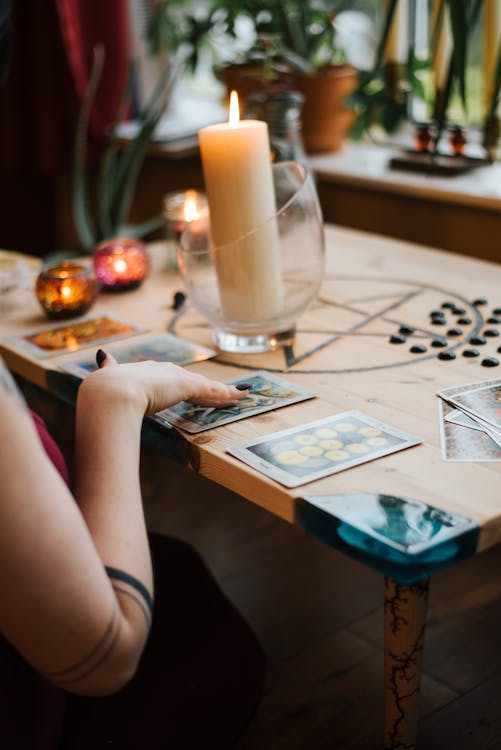A friend of mine is really into tarot cards and often does readings. I’ve always been interested in such cards, but realised I actually don’t know much about them. Or well, not much about their history. So, I asked Wendy to give us some intel about tarot cards. Because they’re not as ‘scary’ as they seem!
1. Part of Italian storytelling games
Europeans became quite interested in card games with the arrival of Mamluk cards, they had to invent new card games. One of those spurred the creation of the tarot deck. Thanks to this, it’s believed that reading tarot cards started as a storytelling game popular with Italian nobility. So, the first version of this was about creativity, instead of trying to discern information about life with the mystical interpretations psychics now use.
2. Made up stories
The game was called cards of triumph (carte da trionfi). These cards featured ornate designs with figures and symbols. They arranged the cards at random as players made up their own silly poems and stories based on each symbol.
3. French occultists transformed the game
A note before you read on: they may have been influenced by the occult, but they aren’t always associated with occultists. That being said, the seemingly innocent origins of tarot cards were transformed by French occultists into the mystical and powerful practice that they are today. Thanks to Jean-Baptiste Alliette, it was believed they were magical. Then, in 1781, Antoine Court de Gebelin claimed that they were based on Egyptian religious texts. Once he published a study, the idea of tarot cards having a religious background started to catch on.

4. Two decks
Today’s tarot cards are made up of two decks: the Minor Arcana and the Major Arcana. They include batons, coins, cups and swords. But, there are several different variations. Aleister Crowley is responsible for reinventing the tarot deck to the Thoth deck. Crowley also went on to add in influences from Kabbalah and other religions.
5. It’s open to interpretation
There’s not a right or wrong way to interpret the card. Many people choose to go to a specific person to have them read their cards, so each person will give their own meaning to each card. This is thanks to the various back stories behind the history of the cards.
6. No bad tarot cards
Some people shy away from certain cards, but there aren’t any bad ones to begin with. Sure, cards like the devil and death may cause fear, but their meanings aren’t inherently negative. It depends on the reading, but you may find that you simply have to address these topics in your life. The cards act as a way for psychics to read you, rather than to tell you the future. With the previous explanation in the back of your head, it’s also up to you to choose how you receive the information. Say the reading is negative, it can still show a positive take away as the types of cards have multiple meanings. For instance, a death card might mean that something in your life will come to an end, and that you’re ready to start a new chapter.

Love, Deem/Skye Lewis ❤
You can also follow me on Facebook, Twitter, Instagram and Twitch
Image source: Pexels

Kies een deck altijd vanuit gevoel.
Er bestaan er zoveel maar een deck moet qua tekening en tekst goed aanvoelen.
Aum Shanthi
LikeLiked by 1 person
I didn’t know that before, but now I do haha
LikeLiked by 1 person
🙏
Aum Shanthi
LikeLiked by 1 person
💪
LikeLiked by 1 person
I’ve never been really interested in this ^^
LikeLiked by 1 person
Which is fair!
LikeLike
Oh two decks? I didn’t know that!
LikeLiked by 2 people
Me neither!
LikeLike
And here I thought my life was doomed when I got a ‘bad’ card once…
LikeLiked by 1 person
No it’s not!
LikeLike
Oh fun to know! Learned a lot more about this 🙂
LikeLiked by 1 person
Glad to hear!
LikeLike
Thank you Wendy for this insight!
LikeLiked by 1 person
I couldn’t agree more with this!
LikeLike
I’ll definitely let someone read my cards someday, I’m intrigued!
LikeLiked by 1 person
I hope it’ll be a good one!
LikeLike
Tarot cards are based on symbols only, a reader can predict with his/her intuitive power using the cards.
Spirituality Awakening
LikeLiked by 1 person
Interesting! Thanks for sharing!
LikeLiked by 1 person
Most Welcome 🙂
LikeLiked by 1 person
🙂
LikeLiked by 1 person
Great overview – the mystery of the archetypes behind tarot is ancient I believe, but your summary of the concepts moving into broader society and beyond the mystery school/occultists is brilliant. 🙂
LikeLiked by 1 person
Thank you for the kind reply, appreciate that!
LikeLiked by 1 person
Love that Tarot Tattoo on your hand ❤
LikeLiked by 1 person
Oh it’s a photo from Pexels! Not mine!
LikeLiked by 1 person
oh i see 😀 i thought it was yours 🙂
LikeLiked by 1 person
I wish!
LikeLiked by 1 person
Hahahaha 😀
LikeLiked by 1 person
😁
LikeLike